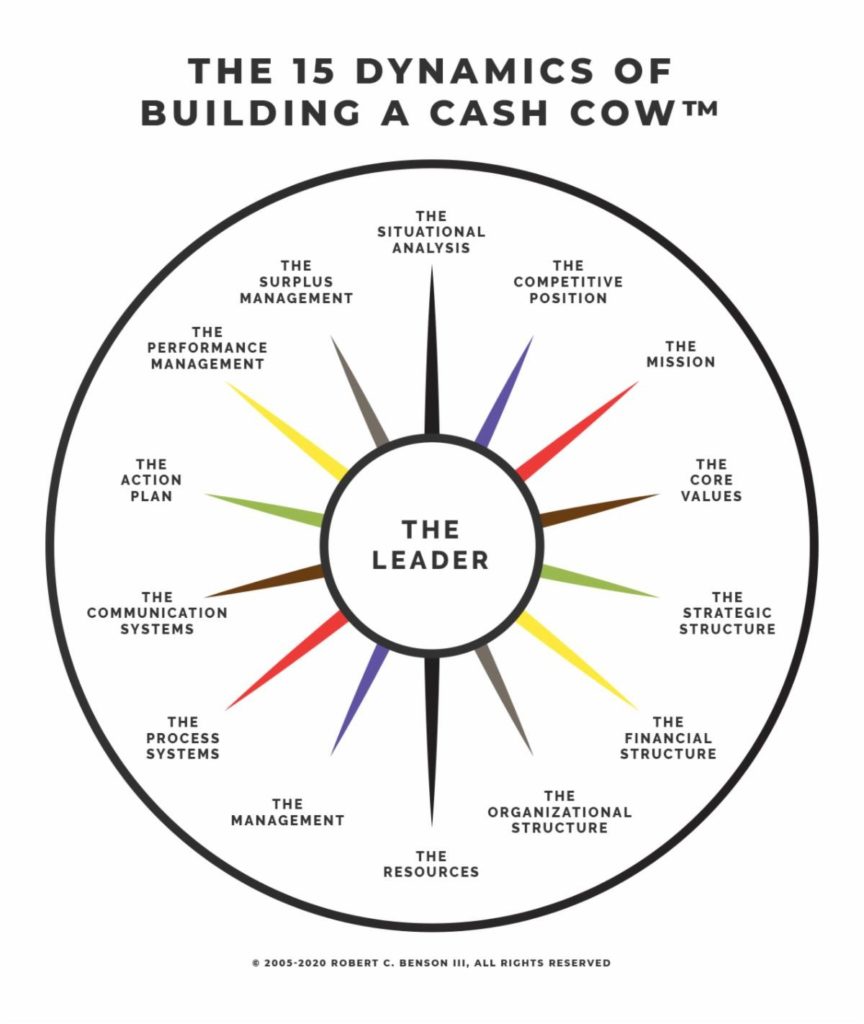The 15 Dynamics of Building a Cash Cow™ PART 2
THE SITUATIONAL ANALYSIS
I am writing a series of articles on The 15 Dynamics of Building a Cash Cow™. Most of the articles, including this one, are applicable to both profit and non-profit companies. As it happens, this month’s topic is good timing for your 2021 planning.
Recap
IN THE INTRODUCTION, I presented the insight that “all data is not equal.” Ralph Waldo Emerson noted that “the value of a principle is the number of things it will explain.” Why? Because it is transferable to many applications and realms of our life, including business. Then we discussed the insight that is even more powerful: “the value of a Driving Principle is the number of things it will do for your company.” Why? Because they have the power to drive the culture, growth, profits, cash flow, and overall success of your company to the next level and beyond.
IN PART 1, THE LEADERSHIP, I created the awareness of the Driving Principle: “The leader’s belief system determines the effectiveness of the leader and the Company”. Why? Because “the company is but a shadow of its Leader” Ralph Waldo Emerson.

What the leader believes to be reality is reflected and integrated into a company through his/her behavior and decisions. I know it’s intimidating, but consider how the beliefs of a U. S. President affect you & the country, and a governor has on you and the state you live in. Think about the impact the leaders of the companies you worked for had or have on you and those companies. And the impact your parents had or have on you and your family.
My objective is to empower you with sound valuable profit and growth Driving Principles.
“The first responsibility of the leader is to define reality.” Max De Pree
The belief of the majority of small company (defined by the SBA as under 100 employees) leaders is that business planning is a waste of time or that it can be accomplished within one or two days at a weekend retreat. The truth is that business planning is the most productive time you can spend. It significantly impacts the clarity, focus, decisions, productivity, culture, and desired results of every person in the company! We will be discussing the impact of a Driving Principle on your business planning considerations in each of the 15 Dynamics articles.
The Situational Analysis
A sound business or organization plan begins with a Situational Analysis. The Driving Principle: To know where you are going, you must first know where you are.
In the ’80s and ’90s, most of our small company clients did not have concerns about competition with large national and international competitors. But at the beginning of the 21st century, such competition for small companies was growing rapidly. In 2004, a small manufacturing company (SMC) came to me concerned that international and national competitors were moving into their industry in a significant way. The SMC finished 2003 with about $3M in revenue and $100K in net income before taxes.
I recommended they develop a formal, comprehensive written strategic business plan using the new Strategic Business Planning process that we had just engineered for small companies. It was designed to effectively compete with all sizes of competitors. Our planning was patterned after the same approach and strategies that MBAs use for larger companies. However, we scaled down the complexity for small companies to be able to understand and afford. I assisted them in the development and implementation of the plan, including the strategic engineering of a new mission statement, competitive positioning statement, core values, strategic imperatives, and target objectives. It was designed to help SMC thrive while competing against small, midsize, national, and international companies.
As competitors moved into Colorado and time progressed, SMC not only held their position in the Colorado market, they became Colorado’s leader in the industry. In fact, they became a national leader in the innovative approach they were using. Interestingly, one of their competitor’s salespersons approached SMC at a conference and told them that “when I prospect for business in the industry, I ask the prospect which supplier they use. When they replied SMC, I just turn around and leave because it is impossible to get customers away from you.” In 2019, the owners sold SMC to a national company at a premium price and retired!
The driving principles behind their success are included throughout these articles utilizing The 15 Dynamics of Building a Cash Cow™.
As always, we started their strategic planning and design with the following situational analysis.
COMPETITOR ANALYSIS
The place to begin is by determining where you are in relation to your competitors. Start by meeting with your leadership team and write down an evaluation of your primary competitors using the form below. Do this prior to the next meeting to perform a SWOT analysis. In your meeting, I encourage you to allow an honest and non-threatening brainstorming discussion. It helps define reality for you to build a sound plan with. Upon completion, e-mail a copy to all your team members.

“…Any enterprise is built by wise planning, becomes strong through common sense, and profits wonderfully by keeping abreast of the facts.” Proverbs 24:3-4 LTB
THE SWOT ANALYSIS
The “SWOT analysis (or SWOT matrix) is a strategic planning technique used to help a person or organization identify strengths, weaknesses, opportunities, and threats related to business competition or project planning. This technique, which operates by ‘peeling back layers of the company,’ is designed for use in the preliminary stages of decision-making processes and can be used as a tool for evaluation of the strategic position of organizations of many kinds (for-profit enterprises, local and national governments, NGOs, etc.).” Wikipedia
This planning technique should also be done with your leadership team. However, prior to your meeting, have each member of your team write down their personal evaluation of your company’s competitive Strengths, Weaknesses, Opportunities, and Threats.
- Have them consider the Competitors Analysis when doing their evaluations.
- It is very valuable for you to get each person’s individual perspective without discussing their views with others so that each one of them is objective. This approach is helpful for you and each team member to see everyone’s individual perceptions.
- Therefore, encourage them to be candid and independent in filling out the following outline.
- When they analyze the company’s SWOT components, have them evaluate the company as compared to the competition.
- Set a meeting to discuss and brainstorm their responses.
S List Our Top Business Strengths (Compared to the competition)
W List Our Significant Weaknesses (Compared to the competition)
O List Our Important Opportunities
T List the Threats to Our Survival
In your meeting, continue to encourage an open and nonthreatening brainstorming discussion of each section of the SWOT analysis. Begin with the details and then summarize the top 3 to 7 components of each section in a clean form. Set up your next team meeting and email a copy of the final SWOT analysis to all members.
“Our view of reality is like a map with which to negotiate the terrain of life. If the map is true and accurate, we will generally know where we are, and if we have decided where we want to go, we will generally know how to get there.” M. Scott Peck, M.D., The Road Less Traveled
EXTERNAL FORCES ANALYSIS
In your next meeting, have your management team discuss how the following external factors are affecting or might affect your business or organization objectives. Then summarize the key considerations of each component below for your planning and email each team member a copy.
- Government/politics
- Legal
- Social
- Economic
- Technological
- Labor
- Industry & Trade Groups
Now you are ready for PART 3 THE COMPETITIVE POSITION.
YOUR VISION FOR THE FUTURE AND THE DRIVING PRINCIPLES
I encourage you to follow along with me as we examine the Driving Principles and beliefs driving The 15 Dynamics of Building a Cash Cow™. When we are done you will have a valuable blueprint to build your business and accomplish your vision.
In the next article, you will be using the assessments above in PART 3 THE COMPETITIVE POSITION.
Best wishes and stay safe!

MERRY CHRISTMAS AND HAPPY HANUKKAH!
If you have feedback or questions for Bob, email him at bob@CCBAlliance.org. For more information on The Colorado Christian Business Alliance go to CCBAlliance.org. If someone you know would like to receive these BobChats™ email the information to clancaster@abadvisors.com.

